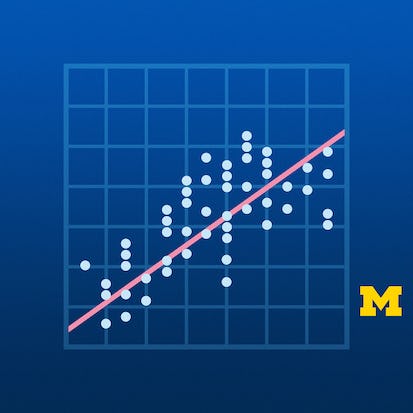- Level Professional
- Duration 15 hours
- Course by University of Michigan
-
Offered by

About
In this course, we will expand our exploration of statistical inference techniques by focusing on the science and art of fitting statistical models to data. We will build on the concepts presented in the Statistical Inference course (Course 2) to emphasize the importance of connecting research questions to our data analysis methods. We will also focus on various modeling objectives, including making inference about relationships between variables and generating predictions for future observations. This course will introduce and explore various statistical modeling techniques, including linear regression, logistic regression, generalized linear models, hierarchical and mixed effects (or multilevel) models, and Bayesian inference techniques. All techniques will be illustrated using a variety of real data sets, and the course will emphasize different modeling approaches for different types of data sets, depending on the study design underlying the data (referring back to Course 1, Understanding and Visualizing Data with Python). During these lab-based sessions, learners will work through tutorials focusing on specific case studies to help solidify the week's statistical concepts, which will include further deep dives into Python libraries including Statsmodels, Pandas, and Seaborn. This course utilizes the Jupyter Notebook environment within Coursera.Modules
About This Course
2
Videos
- Welcome to the Course!
- Fitting Statistical Models to Data with Python Guidelines
4
Readings
- Course Syllabus
- Meet the Course Team!
- Help Us Learn More About You!
- About Our Datasets
Considerations for Statistical Modeling
1
Assignment
- Week 1 Assessment
5
Videos
- What Do We Mean by Fitting Models to Data?
- Types of Variables in Statistical Modeling
- Different Study Designs Generate Different Types of Data: Implications for Modeling
- Objectives of Model Fitting: Inference vs. Prediction
- Plotting Predictions and Prediction Uncertainty
1
Readings
- Mixed effects models: Is it time to go Bayesian by default?
Preparation for Modeling in Python
2
Labs
- Python Libraries
- Getting Started with Modeling in Python
1
Videos
- Python Statistics Landscape
1
Readings
- Python Statistics Landscape
Continuous Dependent Variables
1
Assignment
- Linear Regression Quiz
3
Videos
- Linear Regression Introduction
- Linear Regression Inference
- Interview: Causation vs Correlation
3
Readings
- Linear Regression Models: Notation, Parameters, Estimation Methods
- Try It Out: Continuous Data Scatterplot App
- Importance of Data Visualization: The Datasaurus Dozen
Binary Dependent Variables
1
Assignment
- Logistic Regression Quiz
2
Videos
- Logistic Regression Introduction
- Logistic Regression Inference
1
Readings
- Logistic Regression Models: Notation, Parameters, Estimation Methods
Week 2 Python
2
Labs
- NHANES Case Study: Linear and Logistic Regression
- Practice notebook for regression analysis with NHANES
Week 2 Python Assessment
1
Assignment
- Week 2 Python Assessment
1
Labs
- Week 2 Python Assessment Notebook
Multilevel Models
4
Videos
- What are Multilevel Models and Why Do We Fit Them?
- Multilevel Linear Regression Models
- Multilevel Logistic Regression models
- Practice with Multilevel Modeling: The Cal Poly App
3
Readings
- Visualizing Multilevel Models
- Likelihood Ratio Tests for Fixed Effects and Variance Components
- Link to the Cal Poly App
Marginal Models
1
Assignment
- Name That Model
3
Videos
- What are Marginal Models and Why Do We Fit Them?
- Marginal Linear Regression Models
- Marginal Logistic Regression
Week 3 Python
3
Labs
- Fitting Multilevel and Marginal Models to Autism Data in Python
- NHANES Case Study: Marginal and Multilevel Regression
- Practice: Marginal and Multilevel Regression
Week3 Python Assessment
1
Assignment
- Week 3 Python Assessment
1
Labs
- Week 3 Python Assessment
Special Topics
1
Discussions
- Your Turn: Other Types of Dependent Variables
6
Videos
- Should We Use Survey Weights When Fitting Models?
- Introduction to Bayesian
- Bayesian Approaches to Statistics and Modeling
- Bayesian Approaches Case Study: Part I
- Bayesian Approaches Case Study: Part II
- Bayesian Approaches Case Study - Part III
2
Readings
- Other Types of Dependent Variables
- Optional: A Visual Introduction to Machine Learning
Special Topics: Python
1
Assignment
- Week 4 Python Assessment
1
Labs
- Bayesian in Python
Course Feedback
2
Readings
- Course Feedback
- Keep Learning with Michigan Online
Auto Summary
Elevate your data science skills with the course "Fitting Statistical Models to Data with Python." This professional-level training dives deep into statistical inference techniques, emphasizing the crucial connection between research questions and data analysis methods. Building on prior knowledge, this course covers a range of modeling objectives, from examining relationships between variables to predicting future observations. You'll master various statistical modeling techniques, including linear and logistic regression, generalized linear models, hierarchical and mixed effects models, and Bayesian inference. The course is rich with practical applications, illustrated through real data sets. Each week, you'll engage in lab-based sessions and tutorials using case studies to reinforce your understanding of statistical concepts, with hands-on experience in Python libraries such as Statsmodels, Pandas, and Seaborn. Taught by expert instructors in the Jupyter Notebook environment on Coursera, this 900-hour course is ideal for professionals seeking to enhance their data science expertise. Subscriptions are available under the Starter plan, making it accessible for dedicated learners ready to advance their skills in data modeling.

Brenda Gunderson

Brady T. West

Kerby Shedden


